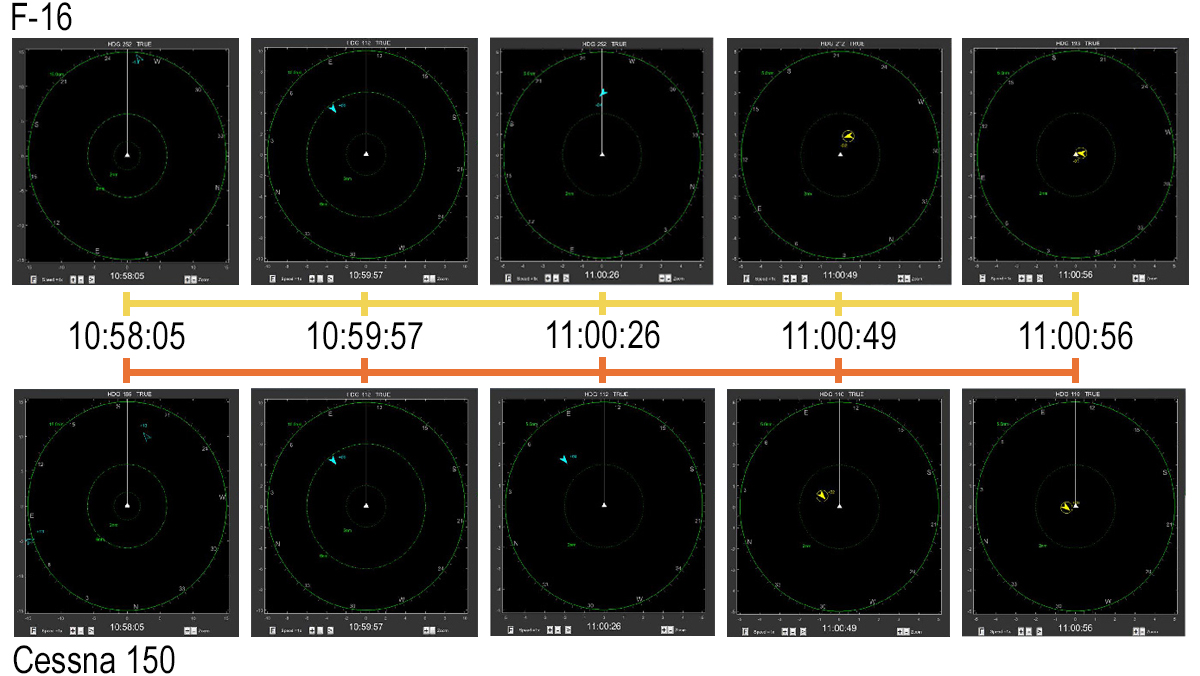Pilots unaware before midair
NTSB: Absent technology a factor
The F-16 pilot flying alone over South Carolina was told 40 seconds before the collision that traffic was straight ahead, two miles away. The Air Force officer had never heard an initial traffic alert so close, he later told investigators. He scanned the sky “aggressively” but did not spot the Cessna 150 over Moncks Corner until it was too late to prevent the collision that claimed two lives. Technology that could have given each pilot ample warning was absent from both aircraft.
The NTSB released a trove of documents Oct. 31, hundreds of pages that detail the July 7, 2015, collision down to the final seconds, as well as a subsequent investigation that exposed the limits of human ability to see and avoid another aircraft, even at close range.
Joseph Johnson, 30, a private pilot working on advanced ratings who was praised as conscientious and competent in the cockpit by his CFI, died while taking his father, Michael Johnson, 68, on what had become a routine excursion. They were squawking 1200 and not in contact with air traffic control. They did not have access to traffic information from the Automatic Dependent Surveillance-Broadcast (ADS-B) system, which could have called attention to the approaching jet.
It is possible, even likely based on the evidence and data available, that neither occupant of the Cessna saw the fast-approaching fighter jet before the collision. Johnson told investigators that he was scanning his radar and allowed the autopilot to fly the evasive turn called for by air traffic control so he could focus more attention on trying to spot the Cessna. He did not see the Cessna until it was about 500 feet away, too late to evade, though he did try. At least one witness on the ground with a clear view of the collision saw the F-16 attempt to avoid the Cessna.
Even before the investigation began, AOPA was working with the FAA to make life-saving technology more available, and affordable. Giving pilots access to modern traffic awareness tools took on fresh urgency after the midair over Moncks Corner.
“See and avoid is an imperfect system for collision avoidance,” said AOPA Air Safety Institute Senior Vice President George Perry, a former Navy fighter pilot and instructor. “This incident spurred an effort to help fix this problem. In August 2015, AOPA asked the FAA to make ADS-B based traffic information available to all general aviation pilots. Currently, the ADS-B system only provides partial and incomplete traffic information to most general aviation aircraft that lack a certified ADS-B system. We are getting close to a decision by the FAA to make this change, and are hopeful that soon pilots with low-cost, portable receivers will have a more complete picture of the traffic around them. Once this change is implemented it will save lives and help pilots prevent this type of accident from happening in the future.”
Within the public docket, a 100-page report details a painstaking study and digital recreation of what each pilot could have seen as the aircraft closed the distance between them in the final minute before the collision. A reconstruction built from available information including radar records and data recorded by the F-16 illustrates how easily a wing strut or instrument panel can hide another aircraft from sight, even at close range.
The study, written by John O’Callaghan of the NTSB Office of Research and Engineering, revealed a limitation that is important for all pilots to know: Small shifts in head position can obscure or reveal an aircraft that occupies a tiny fraction of the visual field. A visual scan without any head movement can leave close-range traffic obscured for a critical fraction of a second. From the Cessna pilot’s perspective, the F-16 may have been obscured from view by the wing strut in the critical final seconds.
“While the visibility of a target airplane in the viewer pilot’s field of view is sensitive to movements of the pilot’s head, the variations in eye position examined … changed the timing of the obscurations of the target aircraft by less than +/-1.5 seconds at any given point,” O’Callaghan wrote. “Nonetheless, the results indicate that looking for traffic can be more effective if the pilot moves his head as well as redirecting his eyes, since head movements may bring otherwise obscured aircraft into view.”
The NTSB also created, based on data from both radar and the ADS-B system, exactly what a cockpit traffic display and alerting system would have shown each pilot.
Such a system, investigators wrote in the report, “could have alerted each pilot to the presence of the other airplane, and presented precise bearing, range, and altitude information about each target, up to two minutes and 50 seconds prior to the collision. Such timely and information-rich traffic presentations would likely have enabled each pilot to avoid the other airplane using only slight course and/or altitude adjustments, and without the need for aggressive maneuvering.”
The NTSB will meet Nov. 15 to vote on the probable cause of the crash.





